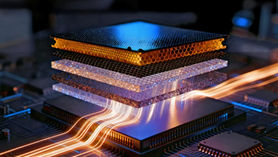Neutrinovoltaic - the principle of power generation under the influence of ambient radiation fields
- Наука и техника, https://naukatehnika.com
- Oct 29, 2022
- 5 min read
Updated: Dec 8, 2022
The development of Neutrinovoltaic technology started in the process of experiments to optimize the operation of solar panels: nanoparticles of various materials were used for experimental work in order to achieve the largest possible active physical surface to increase the efficiency of solar panels, but such experiments were not successful. It was noted that the test material showed signs of instability, with vibrations that did not contribute to improving the surface of the solar cells. These vibrations, the origin of which at that time was inexplicable, forced scientists to continue work on amplifying vibrations, based on the assumption that if vibrations occur in the material, then they can be led to the resonance of atomic vibrations, and hence to the generation of electricity.

The principle of operation of Neutrinovoltaic technology is based on the "ability" of graphene to "collect" energy from the environment, which was accidentally discovered by physicists at the University of Arkansas (USA). It turned out that graphene (a two-dimensional allotropic modification of carbon formed by a layer of carbon atoms one atom thick. Carbon atoms are in sp² hybridization and connected via σ- and π-bonds into a hexagonal two-dimensional crystal lattice), due to the features of the crystal lattice, cannotexist in the 2D plane, but only in the 3D plane.
To exist separately from each other, graphene must behave like a 3D material to provide the necessary stability. The “loophole” is the displacement of mobile atoms, which gives graphene the properties of the third dimension. In other words, graphene was never 100% flat, it vibrated at the atomic level so that its compounds did not undergo spontaneous decay. A group of physicists at the University of Manchester, led by Paul Thibado, have shown that the explanation lies in the so-called "Lewy flights" - patterns of small random fluctuations, combined with sudden, sharp shifts. On an atomic scale, physicists saw them for the first time. By measuring the speed and scale of these graphene waves, Thibadot suggested that they could be used to extract energy from the environment.
This problem was successfully solved by scientists from the scientific and technological company Neutrino Energy Group under the guidance of mathematician Holger Thorsten Schubart. It should be noted that all the characteristics of the innovative multilayer nanomaterial created by the company, consisting of alternating layers of graphene and doped silicon, were obtained experimentally several years ago, and only in recent years have separate theoretical confirmations of the fundamentals appeared in open sources, proving the functionality of the model proposed by the Neutrino Energy Group.
For example, in the journal Nature, ETH (Eidgenössische Technische Hochschule, Zürich) professor Vanessa Wood and her colleagues explain what processes cause atomic vibrations when materials are nanosized, and how this knowledge can be used to systematically develop nanomaterials for various applications. The publication shows that when materials are produced with sizes less than 10–20 nanometers, that is, 5000 times thinner than a human hair, the vibrations of the outer atomic layers on the surface of the nanoparticles are large and play an important role in how this material behaves. All materials are made up of atoms that vibrate. These atomic vibrations, or "phonons", are responsible for how electrical charge and heat are transferred in materials.
Scientists from the University of Vienna, the Advanced Institute of Science and Technology (AIST) in Japan, JEOL and La Sapienza University in Rome have developed a technique that can measure all phonons present in a nanostructured material. Thus, for the first time, they were able to establish all the vibrational modes of autonomous graphene, as well as the local expansion of various vibrational modes in a graphene nanofiber. This new method, which they called "large q mapping", opens up completely new possibilities for establishing the spatial and momentum expansion of phonons in all nanostructured as well as two-dimensional modern materials. These experiments open up new possibilities for studying local modes of oscillations on the nanometer scale down to specific monolayers.
A group of scientists from MIT (Massachusetts Institute of Technology) managed to turn graphene into a superconductor, through which electricity is transmitted without resistance. The discovery of the fact that graphene is capable of superconductivity will in the near future mark the beginning of a whole series of research in this area. Since graphene is a key element in the composition of the material invented by Neutrino Energy Group, its superconductivity property will play a key role, especially for powering electrical appliances where a small and stable power supply is required.

The Neutrino Energy Group has gone much further than other research groups with regard to the application of knowledge in this area and secured its undisputed priority by obtaining an international patent under the number WO2016142056A1. The Neutrinovoltaic technology is based on the use of ultra-thin layers of graphene to create a resonance of vibrations of graphene atoms under the influence of thermal Brownian motion and ambient radiation fields of artificial and natural origin, including cosmic neutrinos, and convert the kinetic energy of particles of the surrounding radiation fields into electric current. Conduction electrons and "holes" in graphene have zero effective mass, i.e. they cannot be motionless, but move all the time with the "Fermi velocity", which in graphene is approximately 106 m/s, that is, it is already relativistic. This is the reason for the very high mobility of electric charge carriers in graphene, which is at least 2 orders of magnitude higher than their mobility in silicon, and the "ballistic" nature of their motion along the film. The mean free path of conduction electrons and holes in graphene at room temperature exceeds 1 μm.

To achieve the desired effect, several layers of graphene and doped silicon are applied to a metal foil substrate, and when radiation passes through this combination of silicon and graphene layers, a harmonic resonance process starts. The optimal composition of such a material assumes the presence of 12 alternating graphene-silicon layers with a total ratio of 75/25%. The superposition of the frequency of the external action of particles of the surrounding radiation fields, including the action of neutrinos, on the internal frequency of oscillations of graphene waves caused by the thermal Brownian motion of graphene atoms enhances such oscillations and leads to the appearance of resonance. Atomic vibrations at resonance enhance the recoil of electrons upon contact with doped silicon. The use of graphene with almost no impurities and the use of doping "forces" graphene electrons to flow in one direction, that is, an electric current occurs. The overall effect is what physicists call "oblique scattering," where clouds of electrons deflect their motion in one direction.
Multilayer coating on one side of the foil results in different poles: the coated side has a positive pole and the uncoated side has a negative pole, allowing them to be stacked on top of each other and pressed together to obtain a reliable serial connection of the plates. One plate with a size of 200x300 mm creates a voltage of 1.5 V and a current of 2 A. Based on Neutrinovoltaic technology, Neutrino Energy Group managed to create a fuel-free generator (FTG) of the so-called "free energy" without rotating parts.
Licensed industrial production of Neutrino Power Cube free energy generators with a net power of 5-10 kW will begin in Switzerland in late 2023 - early 2024. It will be produced in the form of an electrical panel (cabinet), which will conditionally be divided into 2 sections: the power generating section, where the power generating modules are located, and the section for installing the control system. The generating compartment has a size of 800x400x600 mm and a weight of about 50 kg. The control system section will house inverters for converting the generated DC into AC with a voltage of 220 V and 380 V, there is also a DC connector for direct connection of computers and various devices and gadgets.
The applied application of the technology promises to be multifunctional, which will undoubtedly make it in demand in the coming years, given the transformation processes of the modern energy sector.
Author: Rumyantsev L.K., Ph.D.























































Comments